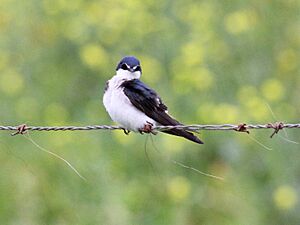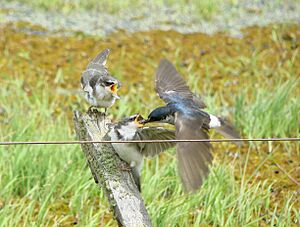White-rumped swallow facts for kids
Quick facts for kids White-rumped swallow |
|
|---|---|
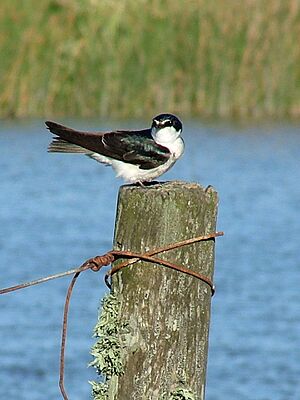 |
|
| In Buenos Aires | |
| Conservation status | |
| Scientific classification | |
| Genus: |
Tachycineta
|
| Species: |
leucorrhoa
|
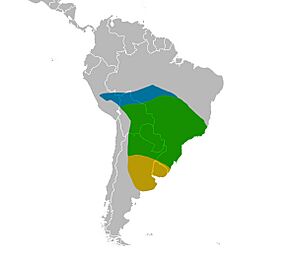 |
|
| Range of T. leucorrhoa
Resident range Breeding visitor Winter visitor |
|
The white-rumped swallow (Tachycineta leucorrhoa) is a small, fast-flying bird in the swallow family. It got its scientific name from a French bird expert, Louis Pierre Vieillot, in 1817. For a long time, people thought it was just a type of Chilean swallow. This bird is special because it has a white stripe above its eye, which helps tell it apart from the Chilean swallow.
Its wings, tail, and the area around its eyes are black. The rest of its top feathers are a shiny blue. Its belly and the feathers under its wings are white, just like its rump (the back part of its body), which gives it its name! Both male and female white-rumped swallows look very similar. Young birds are a bit duller and browner.
These swallows usually build their nests in holes in trees or under parts of buildings. They like to nest alone, in separate pairs, during the breeding season. This season runs from October to December in Brazil and from October to February in Argentina. They usually lay one group of four to seven eggs. The female sits on the eggs for about 15 to 16 days. The young birds are ready to fly about 21 to 25 days after they hatch.
You can find this swallow in countries like Argentina, Bolivia, Brazil, Paraguay, Peru, and Uruguay. It lives in open areas like dry savannas, grasslands, and the edges of forests. It also likes places near human homes. The International Union for Conservation of Nature (IUCN) says this bird is a "least concern" species, meaning it's not in danger. Its numbers are actually growing, partly because it can use human-made places to nest.
Contents
About the White-Rumped Swallow
The white-rumped swallow was first officially named Hirundo leucorrhoa in 1817. Later, it was moved to its current group, Tachycineta. The name Tachycineta comes from an old Greek word meaning "moving quickly." The second part of its name, leucorrhoa, means "white rump" in Greek. This perfectly describes one of its main features!
People used to think this bird was a type of Chilean swallow because they look and sound similar. But studies of their DNA show they are different species. This swallow is called the white-rumped swallow because of its white rump. Sometimes, it's also called the white-browed swallow because of the white stripe above its eye.
What Does It Look Like?
The white-rumped swallow is about 13 centimeters (5 inches) long. It weighs between 17 and 21 grams (about 0.6 to 0.7 ounces). It has a white stripe above its eye and black feathers around its eyes and ears. These black feathers have a shiny blue-green color.
Its wings are black, with white tips on some of the inner feathers. These white tips can wear away as the bird gets older. Its tail is black and has a slight fork shape. As its name suggests, it has a white rump, though it might have a few thin dark lines. The rest of its top feathers, including its head and neck, are a glossy blue. When it's not breeding, this blue color can look more greenish-blue. Its belly and the feathers under its wings are white. Its beak, legs, and feet are black, and its eyes are brown.
Male and female swallows look alike. Young birds are duller in color and browner, with a slightly darker chest. The white-rumped swallow looks a lot like the Chilean swallow. But the Chilean swallow does not have the white stripe above its eye. Also, the Chilean swallow keeps its glossy blue top feathers even when it's not breeding. The white-rumped swallow is also a bit bigger than the Chilean swallow.
The song of this swallow sounds like a soft gurgling or a broken warble. It often sings while flying early in the morning. Its call is a quick, soft "zzt." When it senses danger, it makes a short, harsh sound.
Where Does It Live?
This swallow lives in Argentina, Bolivia, Brazil, Paraguay, Peru, and Uruguay. It likes open and partly open areas, especially near water. You can find it at the edge of forests and near human towns. It also lives in dry grasslands and areas that flood sometimes. It is known to live in the flat grasslands of Argentina and Uruguay called the pampas. During the colder months in the southern part of its range, these birds often fly north. You can find this bird from sea level up to about 1,100 meters (3,600 feet) high.
How It Behaves
After the breeding season, white-rumped swallows gather in large groups. These groups can have hundreds of birds. They often mix with other types of swallows in these big flocks.
Nesting and Reproduction
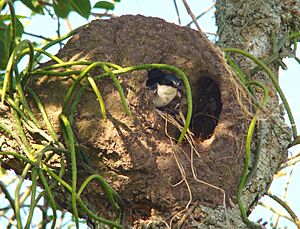
The white-rumped swallow builds its nest in holes or cracks in trees. It also uses human-made places, like holes in fence posts or under the roofs of old buildings. These swallows sometimes use the same good nesting spots again, which helps their young survive. They might even use old nests built by other birds, like the rufous hornero. Their nests are usually made of plant fibers and lined with hair and feathers.
These swallows nest alone, with pairs spread out during the breeding season. You might see pairs fighting or chasing each other near their nest. They also visit other possible nesting spots, even if they are already nesting. This behavior helps them find good places for future nests. If a nest fails, they will travel much farther to find a new spot.
The breeding season is from October to December in Brazil. In Argentina, it's from October to February. Usually, they raise one group of young, but sometimes they will have a second group. About 58% of nests successfully raise at least one chick.
They usually lay four to seven eggs. The eggs are pinkish-white when laid and turn pure white. Each egg is about 19.6 by 13.7 millimeters (0.77 by 0.54 inches) and weighs about 1.9 grams (0.07 ounces). As the breeding season goes on, the number and size of eggs usually get smaller. The female sits on the eggs for 15 to 16 days. About 58% of the eggs hatch at the same time. On average, 78% of the eggs will hatch. The young birds are ready to fly in 21 to 25 days, and about 95% of them successfully fledge. On average, a white-rumped swallow lives for about 2.12 years. Males tend to live a little longer than females.
What Does It Eat?
The white-rumped swallow eats insects it catches while flying. It usually feeds alone or in small groups. It eats flies, beetles, flying ants, grasshoppers, and moths. It often flies low over water, pastures, and open woodlands. Its flight is fast and direct. It sometimes follows humans or animals that are moving around, as they can stir up insects.
Conservation Status
The IUCN lists the white-rumped swallow as a "least concern" species. This means it is not currently in danger of disappearing. This is because it lives in a very large area, its population is growing, and there are many of them. More human-made nesting spots might be helping this bird's population grow. It is considered quite common in the areas where it lives.



